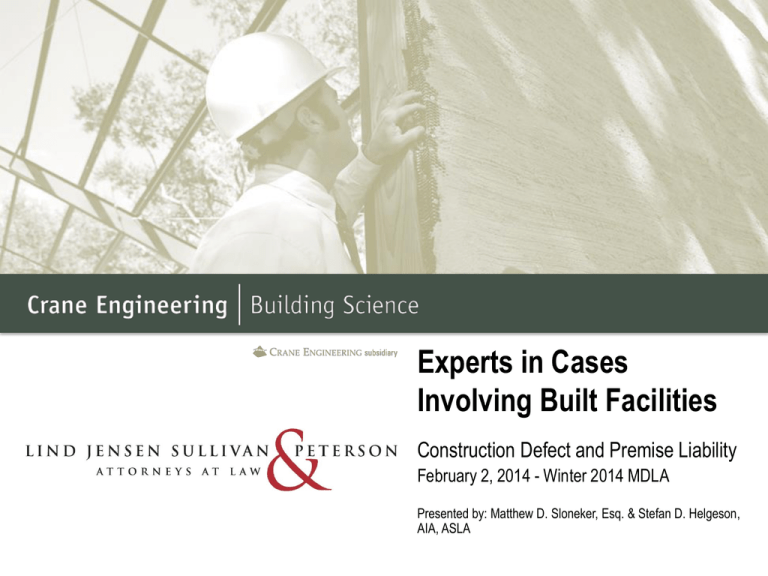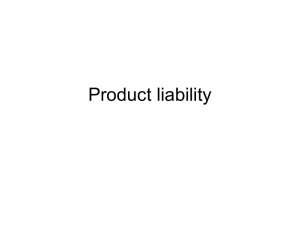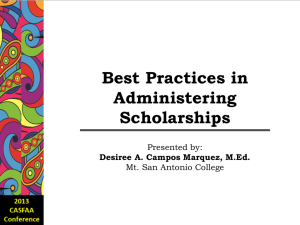MDLA Winter 2014 Presentation
advertisement

Experts in Cases Involving Built Facilities Construction Defect and Premise Liability February 2, 2014 - Winter 2014 MDLA Presented by: Matthew D. Sloneker, Esq. & Stefan D. Helgeson, AIA, ASLA So You Need An Expert… • Construction Defect or Premises Liability? • Engineer or Architect? • Egghead or experienced contractor? • Forensic specialist or likeable actor? 2 3 Construction Defect Claims • Statutory Liability: § 327A New Home Warranties ― 1-Year Warranty – defects caused by faulty workmanship or defective materials due to noncompliance with building standards ― 2-Year Warranty - defects caused by faulty installation of plumbing, electrical, heating, and cooling systems due to noncompliance with building standards ― 10-Year Warranty - major construction defects due to noncompliance with building standards • Minn.Stat. §327A.03 Exclusions (selected) ― The liability of the vendor … does not extend to the following: (e) loss or damage from normal shrinkage caused by drying of the dwelling….within tolerances of building standards; (j) loss or damage from failure to maintain the dwelling … in good repair; or (k) loss or damage which the vendee or the owner, whenever feasible, has not taken timely action to minimize. 4 Construction Defect Claims • Statutory Liability: § 327A Home Improvement Warranties ― 1-Year Warranty - defects caused by faulty workmanship or defective materials due to noncompliance with building standards ― 2-Year Warranty - defects caused by faulty installation of plumbing, electrical, heating, and cooling systems due to noncompliance with building standards ― 10-Year Warranty - major construction defects due to noncompliance with building standards ― 1-Year Warranty - defects caused by faulty workmanship or defective materials due to noncompliance with building standards (for home improvements not involving major structural changes or additions) 5 Construction Defect Claims • Statutory liability: Minnesota Common Interest Ownership Act (MCIOA) ― § 515B.4-112 Express Warranties » Affirmations of fact or promises » Models and descriptions of physical characteristics » Descriptions of quantity or extent of real estate » Representations in plats or surveys 6 Construction Defect Claims • Statutory liability: MCIOA ― § 515B.4-113 Implied Warranties » Property suitable for ordinary uses » Improvements free from defective materials and constructed in accordance with applicable law, including sound engineering and construction standards and in a workmanlike manner » Residential use will not violate applicable law 7 Construction Defect Claims • Breach of Contract ― Compliance with plans and specifications ― Defects in materials or workmanship ― Insurance procurement and indemnity obligations 8 Construction Defect Claims • Common law obligations ― ― ― ― ― Duty to use reasonable care Implied covenant of good faith and fair dealing Promissory estoppel Respondeat Superior Owner/Developer implied obligations » Disclose material information » Provide accurate plans & specifications (Spearin Doctrine) » Obtain permits, approvals, and easements » Timely review submittals and requests ― General Contractor’s implied obligations » Build per plans, specifications and codes » Workmanlike construction: of good quality, free of defects, conformed to contract documents 9 Premises Liability Claims • Duties owed by Property Owner ― ― ― ― General duty to use reasonable care for the safety of all such persons invited upon the premises Duty exists whether entrant is a licensee or an invitee Duty is not absolute – landowners are not insurers of an entrant’s safety Other factors in determining scope of duty owed: » » » » ― Duty is modified according to the expected use of the land Foreseeability or possibility of harm Ongoing duty to inspect and maintain property to ensure entrants are not exposed to unreasonable risk of harm Duty to repair or warn (If condition discoverable through reasonable efforts) Entrant also owes duty of reasonable care in ensuring his own safety 10 Whom are You Representing? • Construction Defect and Premise Liability – Owner – HOA – Developer – Tenant – General Contractor / Construction Manager – Sub-contractor – Supplier / Sub to Sub-contractor – Architect / Engineer – Sub-consultant to Architect / Engineer – Other Parties 11 Are you asserting affirmative claims? • Claims Against Professionals - Minn. Stat. § 544.42 Requirements – Applies to attorneys, architects, certified public accountants, engineers, land surveyors, landscape architects, and others licensed under Minn. Stat. Sections 326 or 326A – Define applicable standard of care – Opine that defendant deviated from standard of care – Causation of damages 12 Expert’s Ability to Opine on a Standard of Care • Who can testify as an expert - Minn. R. Evid. 702 ― If scientific, technical, or other specialized knowledge will assist the trier of fact to understand the evidence or to determine a fact in issue, a witness qualifed as an expert by knowledge, skill, experience, training, or education, may testify thereto in the form of an opinion or otherwise. The opinion must have foundational reliability. In addition, if the opinion evidence involves novel scientific theory, the proponent must establish that the underlying scientific evidence is generally accepted in the relevant scientific community. 13 14 Expert’s Ability to Opine on a Standard of Care • Industry Standard of Care ―Construction defect claims ―Often against general and/or subcontractor ―Technical / industry background, education and experience ―Ability to opine on the represented parties’ duties – G.C., sub-contractor, suppliers, etc. ―Familiarization with standards and codes ―Often deals with discussion of “workmanlike construction”, defined as: » Good quality, free from defects and in conformance with contract documents 15 Expert’s Ability to Opine on a Standard of Care • Professional Standard of Care ―Education and Licensure (Minnesota Board of AELSLAGID) » Architects – building type and use specialization, types of experience as a project manager, project architect, specification writer, other » Engineers – structural, civil, mechanical, electrical, other » Land surveyors » Landscape architects » Geoscience » Interior designers • Professional Specialties – medical, safety, human factors, insurance, accounting, real-estate, etc. 16 Expert’s Ability to Opine on a Standard of Care • Engineering Exams Agricultural Architectural Chemical Civil » Construction » Geotechnical » Structural » Transportation » Water Resources and Environmental – Control Systems – Electrical and Computer » Computer Engineering » Electrical and Electronics » Power – – – – – – – – – – – – – – – Environmental Fire Protection Industrial Mechanical » HVAC and Refrigeration » Mechanical Systems and Materials » Thermal and Fluids Systems Metallurgical and Materials Mining and Mineral Processing Naval Architecture and Marine Nuclear Petroleum Software Structural 17 Expert’s Ability to Opine on a Standard of Care • Professional Standard of Care ―The accepted industry standard of care for professional architecture design and administration services is defined by the American Institute of Architects (AIA) as: » The Architect shall perform its services consistent with the professional skill and care ordinarily provided by architects practicing in the same or similar locality under the same or similar circumstances » The Architect shall perform its services as expeditiously as is consistent with such professional skill and care and the orderly progress of the Project 18 Expert’s Ability to Opine on a Standard of Care • Professional Standard of Care ― “One who undertakes to render professional services is under a duty…to exercise such care, skill, and diligence as men in that profession ordinarily exercise under like circumstances.” City of Eveleth v. Ruble, 225 N.W.2d 521 (Minn. 1974). ― “Engineers are not required to produce perfect results, “but rather [to] exercise…that skill and judgment which can be reasonably expected from similarly situated professionals.” Waldor Pump & Equip. Co. v. Orr-SchelenMayeron & Assocs., Inc., 386 N.W.2d 375 (Minn. Ct. App. 1986). ― The standard of reasonable care that applies to the conduct of architects is the same as that applied to lawyers, doctors, engineers and other professionals engaged in furnishing skilled services for compensation. Gammel v. Ernst & Ernst, 72 N.W.2d 364 (Minn. 1955). 19 Expert’s Ability to Opine on a Standard of Care • Failure to Define Standard of Care – Developer’s claims against design engineering company dismissed for failure of experts to establish standard of care – Pond Hollow Homeowners Ass’n v. The Ryland Group, Inc., 779 N.W.2d 920 (Minn. Ct. App. 2010). • Failure to Substantiate Qualifications – Expert offered in support of claims against professional must “make a substantial showing of qualification in the particular field of inquiry.” Swanson v. Chatterton, 160 N.W.2d 662, 669 (Minn. 1968). 20 Expert’s Ability to Opine on a Standard of Care • Expert may also need practical experience in the particular matter at issue ― Law professor with only academic experience not qualified to opine on standard of care applicable to criminal defense attorney – Noske v. Friedberg, 713 N.W.2d 866 (Minn. Ct. App. 2006). ― Psychologist without practical experience not competent to give opinion on standard of medical care or departure therefrom – Lundgren v. Eustermann, 370 N.W.2d 877 (Minn. 1985). • Expert may also be qualified due to related experience ― Professional estimator and certified engineering technician qualified to opine on standard of care of architect based on experience. Prichard Bros., Inc. v. Grady Co., 436 N.W.2d 460 (Minn. Ct. App. 1989). 21 Expert’s Ability to Opine on a Standard of Care • Qualification challenges based on methodology, testing Frye-Mack – General acceptance in relevant scientific community – Scientifically reliable foundation of evidence derived from testing Daubert – “General acceptance” standard superseded by Fed. Rules of Evidence – Is reasoning or methodology scientifically valid? – Can reasoning or methodology be properly applied to facts? – Has theory or technique been tested, subjected to peer review & publication? – Must assist trier of fact (i.e., relevance) 22 Investigation Background and Methodology • Construction Defect - Documents ― Contracts between all parties ― Contract Documents including code review, plans and specifications from time of construction ― Project files including meeting minutes, emails, submittals / shop drawings / RFI’s / ASI’s / Change Orders ― City site documents including planning and zoning approvals, correspondence and staff reports ― City building documents including signed and approved Contract Documents (A, C, M, E, P, S) with city comments and notations, permits, inspections, and CO 23 Investigation Background and Methodology • Premise Liability (slip/trip and fall) - Documents ―Contract Documents including code review and plans and specifications from time of original construction or most recent addition / remodel ―Maintenance records, procedures, products and schedules ―Reports of any previous incidents ―Contracts and invoices with maintenance providers ―City documents, inspections and correspondence 24 Investigation Background and Methodology (Cont.) • Standard of care for involved parties – technical / industry and professional • Notifications • Destructive and non-destructive inspections ― Previous invasive inspections by plaintiff’s experts ― Reliance of discovery by others ― Observation and documentation of process ― Expert disputes on methodology in the field • Acquiring and preserving artifacts ― Sign off by responsible party ― Compliance with ASTM standards E-1492 including chain of custody 25 Seven Steps of the Scientific Method – NFPA 921 1. Recognize the problem (Identify) 2. Define the problem 3. Collect data 4. Analyze the data 5. Develop a hypothesis (inductive reasoning) 6. Test the hypothesis (deductive reasoning) 7. Select the final hypothesis 26 Defense Opinions • Simply respond to claims against client or point the finger at others? • Address issues not raised by opposing expert or let them lie? • Address industry or professional standard of care or both? • What defense arguments are you making? ―We followed applicable industry standards and codes at time of construction or incident? ―We complied with Contract Documents? ―We met standard of care of similarly situated professional? ―We relied on other parties? 27 Thank You! 28 Case Study: Premise Liability Slip & Fall 29 Premise Liability Case Study • Slip and Fall – At 5 a.m. on a winter workday in downtown St. Paul, Elderly Irish business client, Sir Rowan O’Rooney: » » » » » » » » » Parked on the highest level of a nearly vacant downtown parking ramp Proceeded down the 5 levels of the ramp stair to the street level Walked ½ block over snowy and icy sidewalks Proceeded through a plaza area in front of the building and main floor lobby area of a large commercial high-rise Climbed the steps of a non-operating escalator to the skyway level Walked over a short section of wet carpet that had just been shampooed Through a set of double doors into an elevated skyway section over the street. Floor of the skyway was of terrazzo finish, slightly inclined away from his direction of travel. Skyway was lit with artificial lighting and was slightly heated. 30 Premise Liability Case Study • Incident – At mid-section of the skyway: » Left foot slipped forward » Tried to resist the fall » Grabbed for a section of railing along the side of the ramp » The railing pulled loose » Causing Sir Rowan to fall on his back. – He suffered multiple fractures and emotional pain and trauma. – Claims exceeded at least $5M. 31 Premise Liability Case Study • Slip and Fall – Sir Rowan alleged that his injuries were a direct cause of: » Poor signage caused him to park in the upper level of a ramp that was too far from the building entrance » Walk outdoors on poorly maintained sidewalks and outdoor plaza area in front of the building » A cold lobby area » A non-operating escalator » Wet carpet » Double doors that were difficult to push open » A cold skyway » A skyway floor that was overly sloped, slippery and poorly lit. 32 What experts would be necessary to either advance and defend a claim for damages due to injuries? • Medical - injuries • Architects - architectural elements including the location of the ramp from the main building, lobby and skyway design compliance to codes • Chemists - floor surface finishes, maintenance products used for cleaning and mopping and carpet cleaning, • Human factors - incident factors and fall dynamics • Maintenance - reasonable operation of building escalators • Wayfinding - building and ramp signage • Forensic video technicians - record the number of building occupants that use the skyway on a daily basis 33 What experts would be necessary to either advance and defend a claim for damages due to injuries? • Engineers » Civil – ramp design and traffic signage » Electrical - lighting levels compliance to codes » Mechanical HVAC - temperature of the lobby and skyway areas compliance to codes » Mechanical Systems- door operation and closure functions, resistance and compliance to codes » Mechanical Testing – dry and wet static dynamic coefficient of friction measurements of the floor area utilizing Binary Output Tribometer (BOT) testing » Materials - condition, strength and attachment mechanism of the railing » Structural - railing strength compliance to codes » Safety - maintenance and safety warnings 34 What are the necessary documents? • Contract documents » Plans and specifications for the building and ramp from time of original construction or most recent addition / remodel » Railing shop drawings » Signage shop drawings • Maintenance and testing records » Procedures, schedules » Product information including MSDS’s of all maintenance materials and products used for the floor and carpet maintenance » Door closures, escalator and moving equipment » Vendor contracts and invoices • Operation records » Escalator » Heating and cooling of the building lobby area and skyway • • Reports of any previous incidents City documents » Inspections and correspondence, maintenance records of the sidewalks 35 Crane Engineering Building Science We answer clients’ questions regarding defects and failures in building design, construction and materials – and how they can be prevented or resolved. Disciplines • • • • • • • Architecture Structural Engineering Fire Protection Engineering Mechanical, HVAC and Plumbing Systems Electrical Engineering Landscape Architecture Civil & Geotechnical Engineering Services • • • Codes and Contract Review Building Component Analysis Building Design and Reconstruction Types of Buildings • • • • Retail and commercial Industrial and manufacturing Institutional Residential – single and multifamily 36 Thank You! 37








